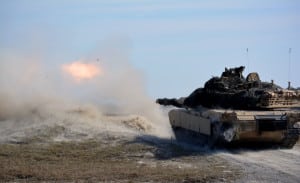The U.S. on Wednesday confirmed plans to provide Ukraine with 31 Abrams tanks, which was announced just hours after Germany approved offering 14 Leopard 2 tanks to assist in the fight against Russia’s ongoing invasion.
Both deals arrive after months of debate regarding the sustainment and maintenance considerations associated with providing Abrams tanks, as well as Germany’s own reservations around allowing other countries to offer their Leopard tanks to Kyiv.

“Today, I’m announcing that the United States will be sending 31 Abrams tanks to Ukraine, the equivalent of one Ukrainian battalion. [Defense] Secretary [Lloyd] Austin has recommended this step because it will enhance Ukraine’s capacity to defend its territory and to achieve its strategic objectives. The Abrams tanks are the most capable tanks in the world. They’re also extremely complex to operate and maintain, so we’re also giving Ukraine the parts and equipment necessary to effectively sustain these tanks on the battlefield,” President Biden said during a press conference on Wednesday. “Delivering these tanks to the field is going to take time, time that we’ll use to make sure the Ukrainians are fully prepared to integrate the Abrams tanks into their defenses.”
Biden said he was “thankful” for German Chancellor Olaf Scholz’s commitment to provide Ukraine with Leopard 2 tanks and for leading “the [new] effort to organize the European contribution of two [Leopard] tank battalions for Ukraine.”
“Germany has really stepped up. The chancellor’s been a strong, strong voice for unity, a close friend and for the level of effort we’re going to continue,” Biden added.
Following a meeting with his German counterpart in Berlin last week, Austin was pressed on the lack of Abrams tanks in new security aid packages and Germany’s reticence to provide Leopard 2 tanks to Kyiv, with Ukrainian officials having reiterated requests for such platforms over the last several weeks (Defense Daily, Jan. 20).
Biden on Wednesday was also asked about reports that Germany wouldn’t offer its Leopard 2 tanks to Ukraine unless the U.S. also committed to sending Abrams tanks as part of future security assistance efforts.
“Germany didn’t force me to change my mind. We wanted to make sure we were all together. That’s what we were going to do all along. That’s what we’re doing right now,” Biden responded.
Deputy Pentagon Press Secretary Sabrina Singh told reporters last week it “doesn’t make sense” to provide Ukraine with Abrams tanks at the moment due to the maintenance and sustainment considerations associated with the platform (Defense Daily, Jan. 19).
The 31 General Dynamics Land Systems [GD]-built Abrams tanks are part of a new $400 million weapons aid package for Ukraine to be procured with Ukraine Security Assistance Initiative (USAI) funds, rather than drawn from existing Pentagon inventories.
“That’s why we’re doing it this way, through USAI. That’s so we can take the time, not too much, but take enough time to make sure that when they get into the field that the Ukrainians can use them and maintain them and keep them in the fight effectively on their own,” a senior administration official told reporters on Wednesday. “Coupled with this near-term commitment that the Germans have made on Leopard [2 tanks], we think that this contribution by us with the Abrams represents the long-term to [Ukraine].”
A senior administration official declined to offer a precise timeline for Abrams deliveries to Ukraine, while adding the nature of the USAI process means “we’re talking months as opposed to weeks.”
Doug Bush, the Army’s top acquisition official, told reporters following the announcement that he couldn’t specify what variants of Abrams will be provided to Ukraine and that senior DoD leaders will be presented with options on how the USAI funds will be used to procure the tanks.
“The Army’s developing options that will be presented to senior leaders on that. I think there are multiple courses of action,” Bush said. “So I don’t know yet, is the answer.”
During an earnings call on Wednesday, General Dynamics Chairman and CEO Phebe Novakovic was asked about the potential for industrial base capacity and staffing issues as it relates to Abrams tank deals that could come together in support of Ukraine.
“Staffing is not an issue here. There’s plenty of capacity on the combat vehicle side both tracked and wheeled. So to the extent that the U.S. government intends to execute any contracts with respect to some of the bilateral agreements that they are developing, we can say it’s well within the capacity of the industrial base to accommodate,” Novakovic responded.
The new $400 million USAI package also includes plans to provide Ukraine with eight M88 recovery vehicles built by BAE Systems, additional support vehicles and equipment and funding for training maintenance and sustainment.
“Secretary Austin is focused on ensuring we deliver a full capability to the Ukrainians. Together with the collective training we’ve been providing, armored capabilities will improve the Ukrainians’ ability to maneuver, which is a critical asset for Ukraine as they continue to defend and reclaim their territory,” a senior administration official told reporters.